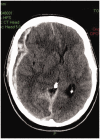A case for stopping the early withdrawal of life sustaining therapies in patients with devastating brain injuries
- PMID: 28979514
- PMCID: PMC5624473
- DOI: 10.1177/1751143716647980
A case for stopping the early withdrawal of life sustaining therapies in patients with devastating brain injuries
Abstract
Early prognostication in patients with a devastating brain injury is not always accurate and can lead to inappropriate decisions. We present case histories to support the recent recommendations of the Neurocritical Care Society that treatment withdrawal decisions should be delayed by up to 72 h in these patients. Development of pathways incorporating these recommendations can improve prognostication, enhance end of life care given to these patients and their families, and increase the opportunities to explore the donation wishes of more patients. They may also standardise the approach to decision making in the same way as the recommendations for management of patients after out of hospital cardiac arrest have done.
Keywords: Devastating brain injury; critical care management; end of life care; neurocritical care; organ donation.
Figures


Similar articles
-
Understanding Early Decisions to Withdraw Life-Sustaining Therapy in Cardiac Arrest Survivors. A Qualitative Investigation.Ann Am Thorac Soc. 2016 Jul;13(7):1115-22. doi: 10.1513/AnnalsATS.201511-751OC. Ann Am Thorac Soc. 2016. PMID: 27073975 Clinical Trial.
-
Neurocritical care physicians' doubt about whether to withdraw life-sustaining treatment the first days after devastating brain injury: an interview study.Scand J Trauma Resusc Emerg Med. 2019 Aug 28;27(1):81. doi: 10.1186/s13049-019-0648-9. Scand J Trauma Resusc Emerg Med. 2019. PMID: 31462245 Free PMC article.
-
Withdrawal of treatment after devastating brain injury: post-cardiac arrest pathways lead in best practice.Anaesthesia. 2017 Oct;72(10):1179-1184. doi: 10.1111/anae.13966. Epub 2017 Jul 11. Anaesthesia. 2017. PMID: 28695979 No abstract available.
-
Management of perceived devastating brain injury after hospital admission: a consensus statement from stakeholder professional organizations.Br J Anaesth. 2018 Jan;120(1):138-145. doi: 10.1016/j.bja.2017.10.002. Epub 2017 Nov 23. Br J Anaesth. 2018. PMID: 29397121 Review.
-
Incidence and impact of withdrawal of life-sustaining therapies in clinical trials of severe traumatic brain injury: A systematic review.Clin Trials. 2018 Aug;15(4):398-412. doi: 10.1177/1740774518771233. Epub 2018 Jun 4. Clin Trials. 2018. PMID: 29865897
Cited by
-
Admission to Intensive Care for Palliative Care or Potential Organ Donation: Demographics, Circumstances, Outcomes, and Resource Use.Crit Care Med. 2017 Oct;45(10):e1050-e1059. doi: 10.1097/CCM.0000000000002655. Crit Care Med. 2017. PMID: 28806221 Free PMC article.
-
Organ donation after circulatory death: current status and future potential.Intensive Care Med. 2019 Mar;45(3):310-321. doi: 10.1007/s00134-019-05533-0. Epub 2019 Feb 6. Intensive Care Med. 2019. PMID: 30725134 Review.
-
Intensive care admission aiming at organ donation. Pro.Intensive Care Med. 2024 Mar;50(3):437-439. doi: 10.1007/s00134-024-07334-6. Epub 2024 Mar 4. Intensive Care Med. 2024. PMID: 38436724 No abstract available.
-
Treatment-limiting decisions in patients with severe traumatic brain injury in a Norwegian regional trauma center.Scand J Trauma Resusc Emerg Med. 2017 Apr 26;25(1):44. doi: 10.1186/s13049-017-0385-x. Scand J Trauma Resusc Emerg Med. 2017. PMID: 28441973 Free PMC article.
-
Determining the impact of timing and of clinical factors during end-of-life decision-making in potential controlled donation after circulatory death donors.Am J Transplant. 2020 Dec;20(12):3574-3581. doi: 10.1111/ajt.16104. Epub 2020 Aug 26. Am J Transplant. 2020. PMID: 32506559 Free PMC article.
References
-
- Souter MJ, Blissitt PA, Blosser S, et al. Recommendations for the critical care management of devastating brain injury: prognostication, psychosocial, and ethical management. A position statement for healthcare professionals from the neurocritical care society. Neurocritical Care. 2015; 23: 4–13. - PubMed
-
- National Institute for Health and Clinical Excellence (December 2011). Organ donation for transplantation: improving donor identification and consent rates for deceased organ donation. Available at: http://www.nice.org.uk/guidance/cg135/resources/organ-donation-for-trans... (accessed 31st January 2016).
-
- Timely Identification and Referral of Potential Organ Donors. A strategy for implementation of best practice. NHS Blood and Transplant 2012. Available at: http://www.odt.nhs.uk/pdf/timely-identification-and-referral-potential-d... (accessed 31st January 2016).
-
- NHS Blood and Transplant 2013. Approaching the families of potential organ donors. Best practise guidance. Available at: http://www.ics.ac.uk/easysiteweb/getresource.axd?assetid=998&type=0&serv... (accessed 31st January 2016).
-
- Hemphill JC, 3rd, Newman J, Zhao S, et al. Hospital usage of early do-not-resuscitate orders and outcome after intracerebral hemorrhage. Stroke 2004; 35: 1130–1134. - PubMed
LinkOut - more resources
Full Text Sources
Other Literature Sources
